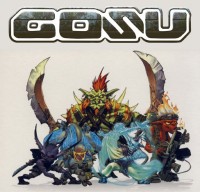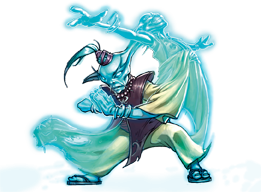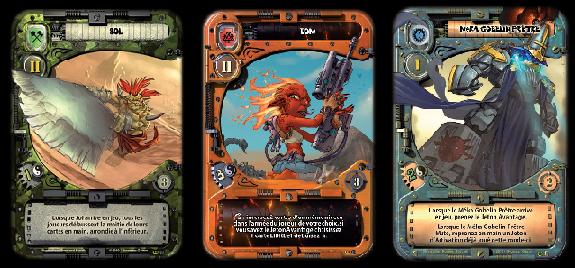
Gosu

The era of the elders has ended, and the war for supremacy has begun. The goblin clans sound the war drums and prepare for battle. Recruit the volatile Fire Goblins, the devious Dark Goblins, the mystical Ancient Gobans, the powerful Alpha Goblins, or the tech-savvy Meka Goblins. Build your armies for the greatest confrontation in goblin history – the battle for Goblin Supremacy!
In GOSU, each player must build an army of goblins, calling on all the clans to create a force that can claim victory on the field of battle. Build powerful combos, exploit your strongest fighters, and when a goblin shows himself too weak, mutate him into a more useful warrior. Use your resources, but use them carefully, because you will run out before you know it. Trap your opponents and use their own abilities against them, and be sure to protect yourself when they do the same to you.

GOSU is the card-based game of goblin army-building for two to four goblin commanders. Fans of collectible card games will love the combinations and strategy, and everyone will enjoy the fantastic art on every card. With strategy and tactics and loads of back-stabbing, GOSU will enthrall and challenge even the most brilliant goblins. Humans will love it, too.

User Reviews (5)
Add a Review for "Gosu"
You must be logged in to add a review.

Gosu is a card game in which players draw and play Goblin cards into three tiers. There are five different Goblin clans, each represented by a color, such as red Fire Goblins or green Alpha Goblins. There are three levels of Goblins, played into three rows. Level 1 Goblins go into your first row, level two Goblins go into your 2nd row, and so on. Each row can have at most five Goblins. Your first level 1 Goblin is free, but any level 1 Goblin of a different clan costs two cards (discarded) to bring into play. You cannot bring in a higher tier Goblin unless you have a lower tier Goblin of the same color.
No row can have more Goblins than the row bellow it, so if you have three Goblins in row one (level 1), you could have a maximum of three Goblins in row two as well. If you wish to replace a Golbin in any given row, many have a mutation cost, that lets the player discard cards from their hand to replace a Goblin with a new one from their hand. This is the only way to add new Goblins to a full row, unless your opponent starts killing them for you. Every Goblin has a combat value that it totaled at the end of each round to determine the round’s winner, who receives a victory point. Level 1 Goblins have 2 Combat, level 2 Goblins have 3 Combat, and level 3 Goblins have 5 Combat. Highest total combat in play at the end of the round wins.
Each goblin has some game text that might trigger effects when coming in to play or when being destroyed. Some of these effects let the player draw cards, make opponents discard cards, or “Trap” enemy cards (flipped them face down for the round, rendering them useless). Many of these effects grow stronger if other players have more victory points than you. Some cards have actions that must be activated with an activation token. You start each turn with two activation tokens which you can use on Goblins with actions or use to draw cards. There is no card draw each turn like in most other card games, so Goblins with card draw effects and activation tokens are a players only way to draw cards after the beginning of the game.
Gosu is a very simple game. The rulebook is short and well written, with some odd humor thrown in. See if you can find the crack on Warhammer 40,000 hidden in the rules! The game is played from one common deck, so it is mostly luck. If you don’t draw Goblins with card draw effects, you will probably lag behind other players. That being said, it’s not to difficult to keep up, and since many effects are more powerful if you are behind in victory points, catching up isn’t very hard. It is a great game to pass the time, though I doubt it will be many people’s top pick.
The replay value might lag a bit, because the goal is always the same: draw as many cards as you can, play as many cards as you can. Some of the level 3 Goblins give alternate victory conditions (like having fifteen Goblins in play, or eight of the same faction), but they are rarely achieved before someone gets their third victory point. The card art is great and I am quite pleased with the production value. I would have liked to see a little more variation in the level 1 and 3 cards’ abilities. For one deck of cards and a few tokens, though, the $30.00 price tag is a bit steep. If you can find it on sale, don’t hesitate. I don’t regret it one bit!
Gosu by Moonster Games
Released in 2010, by French publisher Moonster Games, and designed by Kim Sato, Gosu is a 2-4 player hand management card game where players take part in Great Battles to determine who the greatest Goblin warlord is!
From the first glance I liked this game. Starting with the box and its minimal approach to cover art. Lots of white, blank space here and sometimes this can look lazy or overly pretentious but here it sells the game brilliantly.
The top of the box shows a cadre of different goblins, showing off some of the artwork to be found within. The sides feature just the name on the long side and the publisher logo and age/player info on the short ends. The back is fairly text heavy with a tri-lingual fluff paragraph, contents list and a couple of card images. The minimalist style really helps to make the box pop in a collection and it stands out on the shelf.
The rulebook is really well done with an easy to follow, step by step guide to goblin based warfare. The tokens, 8 activation, 9 victory and 1 advantage token (used mainly for breaking ties and going first in the draw), are printed on some good quality card stock with an ‘okay’ linen finish. The printing and punching are really good. Nice and central and they punched out easily with no mess or tearing.
The 100 goblin cards are the real meat and gravy of this cardboard banquet, and what a tasty bunch they are!
Comparable in quality to almost any card game out at the moment, the card backs have a metallic appearance (although not a metallic finish as many a card gamer will know of the horrendous warping this leads to!) with the logo and a strange goblin faced door knocker thing.
The cards are sorted into five clans. Ancient Goblins (White) Alpha Goblins (green) Dark Goblins (black) Meka Goblins (blue) and Fire Goblins (red) and these clans are further separated into three power levels. Bakuto (Lv.1) Heroes (Lv.2) and Ozekis (Lv.3)
The goblin groups all have a distinctive style and the differing colours between the groups make for an attractive game once on the table. No muted colours here.
The goblins themselves are drawn brilliantly. The art, handled by Bertrand Benoit, Romain Gaschet and Ian Parovel, shows the goblin hordes with unique images, some amusing especially in the case of the cigar chomping, petrol head Fire goblins, to the serene, meditative Ancient Goblins, warlike Alphas, high tech Mekas and the creepy Dark Goblins.
The Bakutos (Lv.1) all have pretty basic names like ‘Dark Goblin Thief’ or ‘Alpha Goblin Shaman’ but the Heroes and Ozekis all have names, and titles in some cases. I really like the fact they went for a completely unique deck with no repetition as that would have been a quick way to bolster the ranks, but the effort in giving us 100 different goblins makes the game all the better for me.
The components in Gosu are great. I think the box could have easily been smaller. I have all of them barring the rule book in an Ultra Pro Deckbox which takes up barely 40% of the available space. Shrink the rules and the box could easily have been made more compact. The fact that I really like the rulebook though renders me a little conflicted in this case! Still all great though.
Gameplay
All 100 cards are shuffled together to form one deck from which all players will draw a hand of seven cards. These are the only free cards you will get!
On a players turn they can take the following actions:
1) Play a Goblin (and use its power if possible)
Each players area is a 5×3 grid in front of them, the first row is for Bakutos, the second for Heroes and the third row (the furthest forward) is for Ozekis. Each player forms their army on this grid.
The first level one goblin you play is free, as are any of the same colour that follow, but for every goblin of a new colour you play you must discard 2 cards from your hand. Heroes and Ozekis require at least one goblin of the same colour be present in the previous layer and as a result they are free to play. Having an assortment of goblins is vital to success so you’ll find yourself discarding quite a lot of cards to build your primary row in the first few turns.
2) Mutate a Goblin
Some goblins have a special icon, coupled with a number, and this indicates that if you discard the indicated number of cards you may mutate it into any other goblin of the same level. This is a nifty way around the limitation of having to have a matching clan colour in the prior level as you can mutate freely.
3) Spend activation tokens for cards
Players can either pay one of their two activation tokens for one card from the deck or both of them for three cards. Aside from a few card effects this is the only way to gain new cards making your choices all the more important with the deliberate choking of resources.
4) Spend an activation token to activate a goblins power
Some goblins have powers on their cards that can only be used by spending a token as opposed to being used when the card is placed. These powers tend to be more powerful or more useful than their free counterparts so you are presented with a choice. New cards? Or kicking some *** with activation powers?
5) Pass
If you choose to pass the round is over for you and you now wait for the other players to finish and pass themselves before moving on to the Great Battle.
‘The Great Battle’
Once all the players have finished forming their forces they face off in the Great Battle. Each player totals the values of their entire force, Bakutos are worth 1 point each, Heroes 2 points and Ozekis 5 points each giving a complete 5×3 army a value of 50 points worth of slobbering gobo fury!
The victor (most points) takes a victory token, any ties go in favour of the owner of the Advantage token. Each player then replenishes their two activation tokens and a new round begins building towards the next Great Battle.
The first player to win three Great Battles wins the war and is declared the greatest goblin warlord.
Gosu is a strange fruit of a game. I love the strategy involved in managing your cards, discards and activation tokens each round and the limitations imposed by the draw mechanic adds another level. At first I wasn’t too sure about the gameplay but it works really well and I soon came to really like it.
I give Gosu 6/10. The game is great as is the artwork but it doesn’t stand up to regular play. A great every now and then title for when you have 15-20 minutes.
GOSU, a game of managing a horde of goblins.
But these aren’t simply a hodge podge of loony gobos, this is organized warfare! AHAHAHA!
It’s surprising how fun this game was for how frustrating and simple the rules appear. 5 rounds in a two player game!?! You only draw up to a hand size at the beginning of the game!?! Only two action tokens!?!? Seems like the game is too quick, too simple and too random.
Yet, the game requires a decent amount of planning, a strategy that will only get more satisfying with more familiarity with with cards and as it turns out, a great hand management game that flows pretty well with a good level of player interaction depending on how the cards are played.
All in all, from a deck of about 100 cards, you get some phenomenal artwork and theme and a value of game richness that exceeds the size of the game.
Combat is super simple, you just add up the values of your horde, but this simplicity focuses the game more to the hand management aspect which normally would seem half-baked, but in this game delivers.
If you want a very back and forth competitive slug-fest type of card game, pass on GOSU. If you want a lightish and quick hand management game that looks great, GOSU will have a place in your collection.
I got this game on Wednesday and yesterday we had a chance to play. I played one 4player game and then a 2player. The game is quite good and we had lots of fun since the whole goblin theme is nice and the abilities on the cards give you the option of playing with or without player interaction. Luck is a major factor, especiallly in a game with 4 players (since there are only 15 level 3 cards and whoever gets thw most usually wins) but the game is nice if you don’t have a problem with that. My only concern is that after a few games the game will probably feel repetitive since there aren’t many variations in the gameplay and the abilities of the cards. Despite this, I think I’ll be willing to play when someone asks me to.
If you like Magic, you will instantly recognize a lot of mechanics. Especially connecting cards (playing them one after another) is very strong in this game and is a staple of Magic too. Because you use the cards as ‘mana’ and as the card itself, you never have to worry about being not able to do something (unless you run out of cards of course).
The artwork is pretty funny, as are the names (I guess I always have to laugh about goblins – overwhelming stupidity in overwhelming numbers).
So if you want a change from a game of Magic, but stay with the same typ of game, this might be one to try. I liked it a lot!